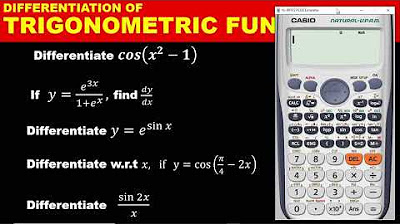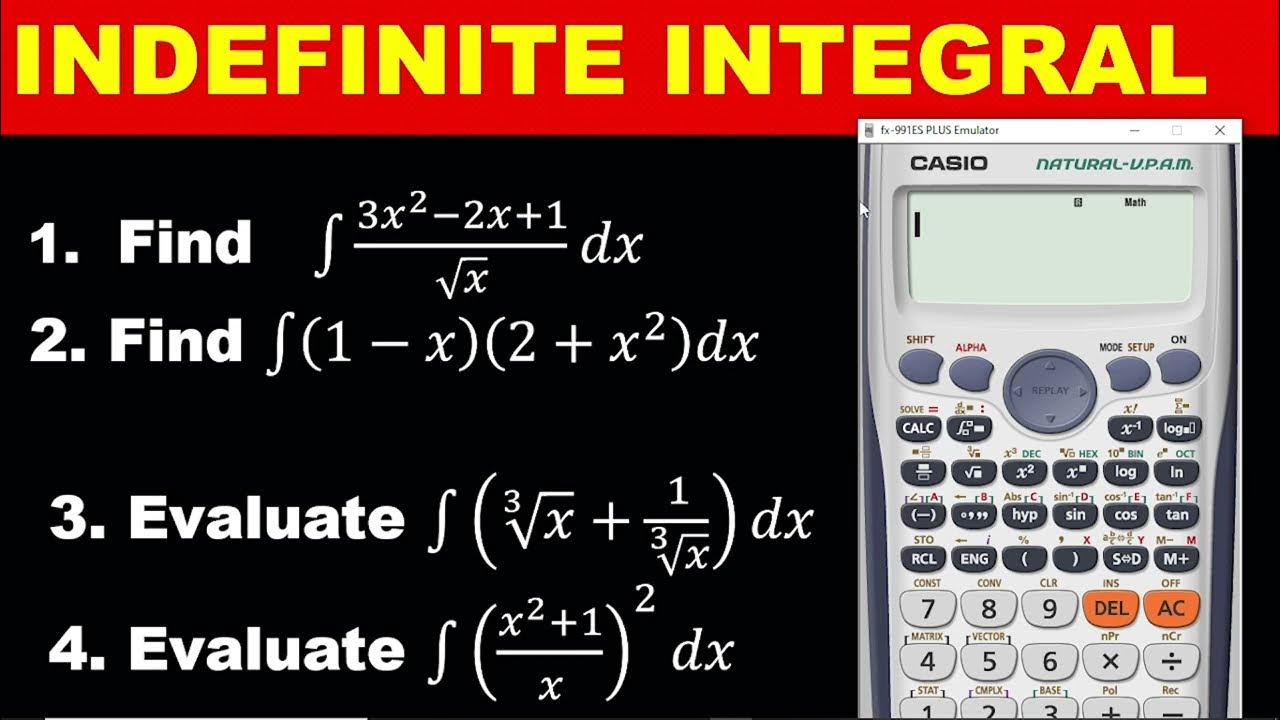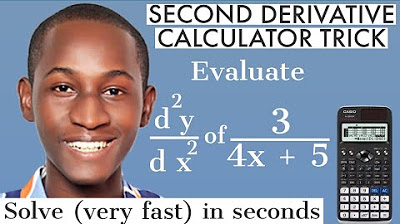Third Derivative Calculator Technique For ENGINEERING BOARD EXAM | ENGR. YU JEI ABAT | #ABATANDCHILL
TLDRThis video script offers an in-depth tutorial on calculating the third derivative using calculator techniques, specifically for the engineering board exam. It introduces the third derivative's approximate formula, explains the process of finding derivatives at three distinct x-values, and demonstrates the method using multiple examples. The script guides viewers through each step, from inputting functions into a calculator to applying the formula and comparing results with multiple-choice answers, concluding with the correct answers for each problem.
Takeaways
- 📚 The video discusses the third derivative calculator technique, part of a series on calculator techniques in mathematics for engineering board exams.
- 🔍 The third derivative formula presented is an approximation and involves calculating the derivative at three distinct x-values: x, x+Δx, and x+2Δx.
- 📉 The formula for the third derivative is f'''(x) = (f'(x+2Δx) - f'(x+Δx)) / Δx - (f'(x+Δx) - f'(x)) / Δx, with Δx chosen as 1×10^-5.
- 🔢 The process involves storing the derivative values at different x-values in variables (C, B, A) for calculation.
- 📈 The example provided demonstrates finding the third derivative of y = x * ln(x) using the calculator technique and comparing the result with multiple-choice answers.
- 📝 The script includes a step-by-step guide on using the calculator to input functions, store intermediate results, and apply the third derivative formula.
- 🤓 The video emphasizes the importance of understanding basic differentiation rules, even when using calculator techniques.
- 📉 The script provides multiple examples, including a function with a natural logarithm and exponential terms, to illustrate the application of the third derivative formula.
- 📝 The process is consistent across examples, highlighting the methodical approach to finding the third derivative using a calculator.
- 🔑 The script concludes with a take-home problem, reinforcing the learning objective of mastering the third derivative calculation technique.
- 🙏 The presenter thanks the audience for watching and expresses a hope that they have learned something valuable from the video.
Q & A
What is the main topic discussed in the video script?
-The main topic discussed in the video script is the third derivative calculator technique, which is part of the study of calculator techniques in mathematics for the engineering board exam.
What is the purpose of the delta x value in the third derivative formula?
-The delta x value in the third derivative formula is used as an approximation factor, chosen to be 1 times 10 raised to negative 5, to calculate the changes in the function values for the derivative approximation.
How does the script describe the process of finding the third derivative using a calculator?
-The script describes the process by first calculating the derivative at three different x values (x1, x2, x3), storing these values in variables (a, b, c), and then applying the third derivative formula to find an approximate value.
What is the significance of storing the derivative values in variables like a, b, and c?
-Storing the derivative values in variables a, b, and c helps in organizing the data and simplifies the process of applying the third derivative formula, making it easier to perform calculations on a calculator.
How does the script handle the approximation in the third derivative calculation?
-The script acknowledges that the third derivative calculation is an approximation and that the final answer may have some decimal places, indicating the level of approximation used.
What is the role of the 'replay' button in the calculator process described in the script?
-The 'replay' button is used to recalculate the derivative values at different x values (x1, x2, x3) by adding the delta x to the previous x value, allowing for the iterative calculation of the derivatives.
How does the script relate the calculated third derivative to the multiple-choice answers?
-The script compares the calculated third derivative value to the options provided in the multiple-choice questions, checking if the calculated value, when divided by the stored third derivative value, is approximately equal to one, indicating the correct answer.
What is the reason for changing the initial value of x from 0.1 to 1 in one of the problems?
-The initial value of x is changed from 0.1 to 1 because the problem specifically asks for the third derivative of the function when x equals one, requiring an adjustment in the x value used for the calculation.
How does the script suggest verifying the correctness of the third derivative calculation?
-The script suggests verifying the correctness by comparing the calculated third derivative value with the options in the multiple-choice answers and checking if the division of the answer by the stored third derivative value is approximately equal to one.
What is the final conclusion the script draws about the third derivative calculation method?
-The script concludes that the third derivative calculation method using the calculator techniques is effective for finding the approximate third derivative of a function, with the correct answer being the one that, when divided by the calculated third derivative, equals approximately one.
Outlines
📚 Introduction to Third Derivative Calculator Technique
This paragraph introduces the topic of using calculator techniques to find the third derivative in mathematics, specifically for engineering board exams. The focus is on understanding the approximate formula for the third derivative, denoted as f'''(x), which involves calculating the derivative at three distinct x-values and using a small change in x, delta x, of 1×10^-5. The process involves storing intermediate derivative values in variables (a, b, c) for further calculation.
🔍 Detailed Calculation of Third Derivative for a Given Function
The paragraph demonstrates the application of the third derivative formula through an example problem where the function y = x * ln(x) is differentiated. It explains the step-by-step process of calculating the first derivative at x-values of 0.1, 0.1+1×10^-5, and 0.1+2×10^-5, storing these in variables a, b, and c respectively. The third derivative is then approximated using the formula and compared with multiple-choice answers to identify the correct one, which in this case is option b.
📈 Applying Calculator Techniques to Power Rule and Composite Functions
This section illustrates the use of calculator techniques for finding the third derivative of more complex functions, including power rules and composite functions. It provides a step-by-step guide on inputting functions into a calculator, calculating derivatives at specific x-values, and using the third derivative formula. The examples include functions like y = 8x^4 + 5x^3 - x^2 + 7 and y = (4x+2)^3 when x=1, with the correct answers being determined through the calculator's approximation and comparison with given choices.
🌟 Advanced Examples of Third Derivative Calculations
The paragraph presents more advanced examples of calculating the third derivative using calculator techniques. It covers functions involving exponential and logarithmic components, such as y = e^(-5x) + 8ln(2x)^4. The process involves inputting the function into the calculator, calculating the derivative at incremental x-values, and applying the third derivative formula. The correct answers are identified by comparing the calculator's approximation with the given multiple-choice options.
🎓 Final Take-Home Problem and Conclusion
The final paragraph wraps up the video script with a take-home problem for the viewers to practice the third derivative calculator technique. It emphasizes the importance of understanding the process and applying it to various functions. The host thanks the viewers for their attention and expresses hope that they have gained knowledge on using calculators to find the third derivative of functions.
Mindmap
Keywords
💡Third Derivative
💡Derivative Calculator Technique
💡Approximation
💡Delta X
💡Engineering Board Exam
💡Function
💡Natural Logarithm
💡Power Rule
💡Euler's Number
💡Multiple Choice
💡Take-Home Problem
Highlights
Introduction to the third derivative calculator technique as part of the study on calculator techniques in mathematics for the engineering board exam.
Explanation of the third derivative approximate formula and its components, including the significance of delta x.
The choice of delta x as 1 times 10 to the power of negative 5 for calculator applications.
Methodology for calculating the first, second, and third derivatives using calculator techniques with specific x values.
Example problem: Finding the third derivative of y = x ln(x) using the third derivative formula and calculator steps.
Storing intermediate derivative values in variables for use in subsequent calculations.
The process of comparing calculated third derivative values with multiple-choice answers to identify the correct formula.
Second example problem involving the differentiation of a power rule function using calculator techniques.
Third example problem with a given x value, demonstrating the adjustment of the calculator technique for specific conditions.
Fourth example problem showcasing the differentiation of a function involving exponential and logarithmic components.
Fifth example problem involving the differentiation of a function with a root and a linear term.
The importance of approximation in calculator techniques and its impact on the accuracy of the results.
Final example problem as a take-home task, reinforcing the learning of third derivative calculation with a calculator.
Emphasis on the practical application of the third derivative calculator technique in solving mathematical problems.
The conclusion of the session with a summary of the key learning points and an invitation to apply the techniques in practice.
Closing remarks expressing gratitude for the audience's attention and wishing them well in their studies.
Transcripts
Browse More Related Video

2nd Derivative + Radius of Curvature Calculator Techniques | Engineering Board exam | Yu Jei Abat

Derivatives Calculator Techniques | Engr. Yu Jei Abat | Ten Examples | Engineering Board Exam

DIFFERENTIATION PART 3: HOW TO DIFFERENTIATE TRIGONOMETRIC FUNCTION WITH THE CALCULATOR

Calculator Techniques FOR BOARD EXAM - Evaluating Functions and Simplifying Expressions 10 EXAMPLES

INTEGRATION PART 1: SIMPLE CALCULATOR TECHNIQUES FOR SOLVING INDEFINITE INTEGRAL- WASSCE MATHS

FAST STEPS TO SOLVE SECOND DERIVATIVE USING CALCULATOR: fx-991 ex | double differentiation
5.0 / 5 (0 votes)
Thanks for rating: